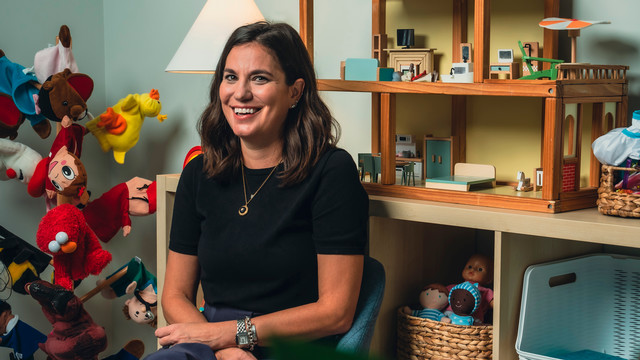Expert
How to help children heal and grow through playtime
University of Richmond alumni are experts in many fields. Maggie Morganfield Parker, ’05, is an expert in play therapy as a form of mental health intervention in children. She is a licensed professional counselor and an associate professor of counseling and human development at George Washington University. Her academic research and clinical experience guide how she engages with both children and parents when it comes to play, and she supervisors other counselors who do the same.
One of her interests is teaching play therapy skills to parents and teachers. Here are a few of her tips for designing and participating in good play with children:
1. Remember that play is a child’s mode of communication.
Parker’s guiding principle is “Toys are their words, and play is their language.” Unlike adults, who can identify the causes behind their emotions, children aren’t as able to express what’s happening in their lives through language. For example, if the parents are going through a divorce, a child painting mostly pictures of family may be their way of coming to terms with their new understanding of what family looks like.
“They’re very present-focused,” Parker said. “It’s hard to talk about the past. It’s hard to understand the future.”
2. Make play spaces predictable, organized, and simple.
New experiences — such as transitioning from summer vacation to a new school year with a new teacher and classmates — are unfamiliar and potentially overwhelming to children. The goal of a play space is to create a comfortable environment that caters to a child’s desire for predictability. A space that meets a child’s expectations each time lowers the chance of them feeling overwhelmed during play.
“I don’t label the toys because that limits the child’s capacity to let them be what they need to be.”
Parker’s playroom has toys for five therapeutic categories: emotional expression, creativity and imagination, nurturing, real life, and aggression. She keeps them organized by category and easy to find, allowing the child to explore them at their own pace.
3. Use reflective responses.
In her sessions, Parker uses reflective responses — reflections about the child’s emotions based on their actions — rather than directly asking them questions about how they feel. For example, if she plays catch with a child and they start to give up, she may identify their frustration but not the cause of it.
“[Reflective responding] helps them match a word to the way their body feels,” she said. “I don’t label the toys because that limits the child’s capacity to let them be what they need to be.”
Reflective responses also establish trust between the adult and child. By acknowledging the child’s emotions and not instructing them how to deal with those emotions, Parker shows that she understands how they feel and has no expectations or judgment in their relationship.
4. Don’t set a limit until a limit is needed.
There are moments during play when Parker has to intervene, such as if a child hits her with a toy or jumps off furniture. She cautions, however, that setting a limit too early, before the child can explore, conveys distrust in the child’s capacity to behave appropriately and can harm the relationship between adult and child. Instead, Parker enters this relationship without establishing expectations. When she has to speak up, she presents it as the child’s choice rather than setting a firm boundary.
“I don’t have to come in and teach anything,” she said. “As long as I am present and engaging in a relationship authentically and genuinely with this child, then they have the whole capacity within them to heal and grow.”
